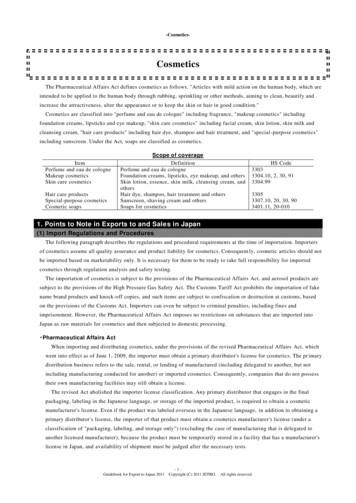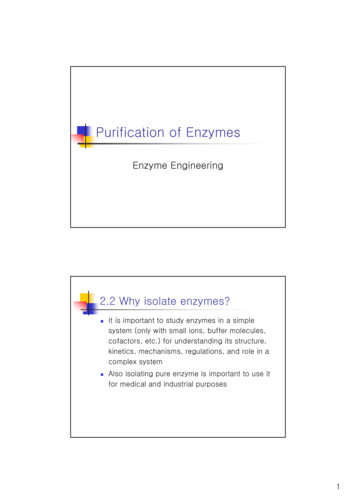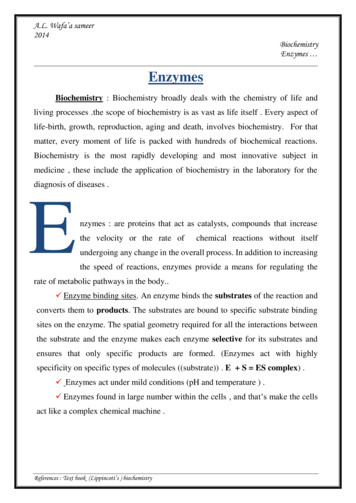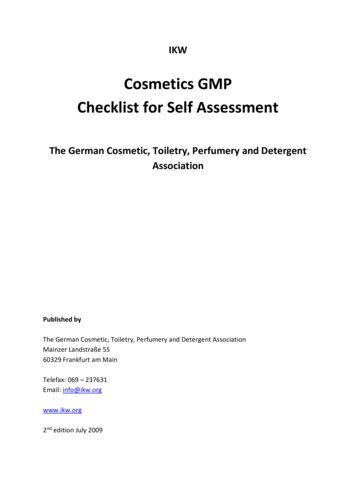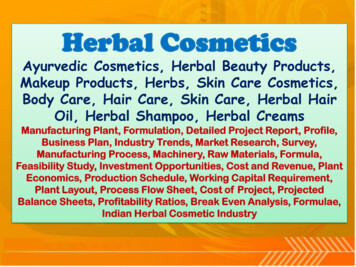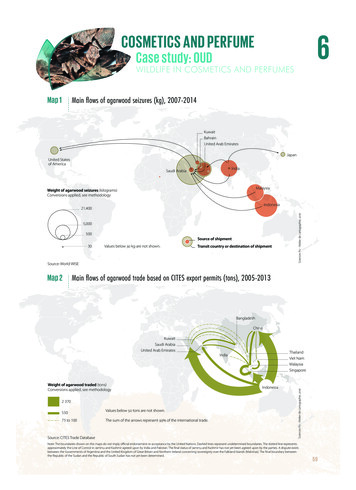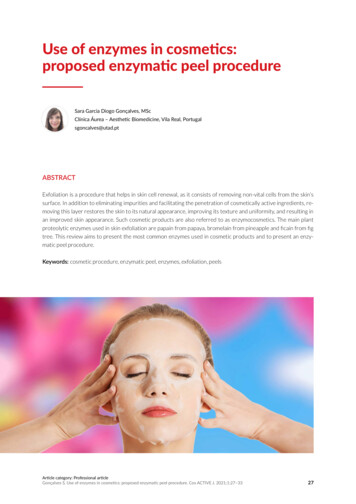
Transcription
Use of enzymes in cosmetics:proposed enzymatic peel procedureSara Garcia Diogo Gonçalves, MScClínica Áurea – Aesthetic Biomedicine, Vila Real, Portugalsgoncalves@utad.ptABSTRACTExfoliation is a procedure that helps in skin cell renewal, as it consists of removing non-vital cells from the skin’ssurface. In addition to eliminating impurities and facilitating the penetration of cosmetically active ingredients, removing this layer restores the skin to its natural appearance, improving its texture and uniformity, and resulting inan improved skin appearance. Such cosmetic products are also referred to as enzymocosmetics. The main plantproteolytic enzymes used in skin exfoliation are papain from papaya, bromelain from pineapple and ficain from figtree. This review aims to present the most common enzymes used in cosmetic products and to present an enzymatic peel procedure.Keywords: cosmetic procedure, enzymatic peel, enzymes, exfoliation, peelsArticle category: Professional articleGonçalves S. Use of enzymes in cosmetics: proposed enzymatic peel procedure. Cos ACTIVE J. 2021;1:27–3327
INTRODUCTIONThe cosmetic industry constantly attempts to develop innovations and alternatives to existing cosmeticproducts. A strong trend has been observed in modern-day cosmetics towards safe cosmetic ingredients of natural origin, particularly to avoid a negativeecological impact on the environment (1). A studyperformed by the Danish Council THINK Chemicalsidentified 65 chemicals of concern in 39 products.The chemicals identified included iodopropynyl butylcarbamate, which is an allergenic; butylparaben,resorcinol and ethylhexyl methoxycinnamate, all ofwhich are classified as endocrine disruptors; glyoxal,which is mutagenic; and zinc pyrithione, a CRM Category 1B substance, which is a presumed human carcinogenic, mutagen, or reproductive toxicant, basedon animal studies (2, 3).As such, consumers are exposed to these chemicals,perhaps daily. An intense investigation into the benefits of what plants and fruits can bring to consumers istherefore required, since it is clear that dermal treatment with active cosmetics can help improve skin rejuvenation (4). This article presents the most commonplant enzymes used in cosmetic products and presents an enzymatic peel procedure.EPIDERMIS AND DERMISThe skin covers an area of about 2 m2 and accounts foraround 15% of the body’s weight, meaning it weighsbetween three to four kilos and is thus the largest andheaviest organ in the human body (5). The skin coversthe entire human organism and is essential for life. Ithas a variable appearance, functions and structure,depending on the body region. The skin is a multifunctional organ that performs vital functions, such as providing an external coating, thermoregulation, a healthymicrobiological environment and defence against external aggressions (cold, heat, pressure, pain, etc.). Itis divided into three layers: the epidermis, dermis andsubcutaneous tissue (6).The epidermis is the most superficial layer of the skinand is in direct contact with the external environment.It is stratified and avascularised epithelial tissue andforms the first line of defence against external factors.It subdivides itself into five layers: the stratum corneum, stratum lucidum, stratum granolosum, stratumspinosum and stratum basale. The stratum corneumhas dead keratin cells that reduce the skin’s permeability, preventing water loss. Keratinised cells helpretain water and form a protective layer that protects against biological, physical and chemical agents (7).The epidermis also protects against ultraviolet rays.Sunlight initially triggers the production of melaninin the stratum basale. Melanin acts as a natural sunscreen for the skin and protects against harmful ultraviolet rays, which is why people get tan when exposedto the sun. However, excessive exposure to the sun candisrupt this process, leading to hyperpigmentation.The dermis is a thick, elastic but firm intermediatelayer located below the epidermis. It subdivides itselfinto two layers: the reticular layer and the papillarylayer (8). It is composed of connective tissue (mainlyfibroblast cells and collagen and elastin fibres) andblood vessels, lymphatics vessels and nerves (7). Itplays an essential role in protecting the body againstexternal and irritating influences, but it also nourishesthe upper layers of the skin from the inside. Its thick,firm texture helps to alleviate external pressures and,when damage occurs, it contains connecting tissues,such as fibroblasts and mast cells that heal wounds.The subcutaneous tissue, which envelops the overallmusculature except for cutaneous muscles, providesfor the passage of cutaneous nerves, blood vesselsand lymph vessels, and plays a role in connecting thedermis and fascia of the muscles (9).EXFOLIATIONExfoliation is the process of removing impurities andkeratinised cells from the skin’s surface, and thinning and making the stratum corneum uniform, tofacilitate the penetration/permeation of cosmeticallyactive ingredients, resulting in healthier-looking skinwith an improved aesthetic appearance (10). An exfoliation can have different depths: superficial, whichreaches from the stratum corneum to the papillarydermis (60 µm); medium, which reaches from thepapillary dermis to the reticular dermis (450 µm); anddeep, which reaches from the mid-reticular dermis to600 µm (11, 12).Gonçalves S. Use of enzymes in cosmetics: proposed enzymatic peel procedure. Cos ACTIVE J. 2021;1:27–3328
Skin exfoliation can be chemical, mechanical or enzymatic (13). Chemical exfoliation includes the use ofacids in the form of, for example, creams, lotions, gelsor solutions. It is a type of aesthetic treatment that isperformed by applying products with acidic formulasof pH 5 to remove the damaged or old layers, andto promote the growth of a new, smooth layer. It isa process that accelerates the cell renewal processfrom the deepest layers of the skin, while the mostsuperficial and older layers are eliminated (11). It actsnon-specifically by reducing the cohesion betweencorneocytes, known as a keratolytic effect (14).Mechanical exfoliation involves the physical scrubbing of the skin with a mild abrasive, such as micro-fibres, adhesive exfoliation sheets, micro-bead facialscrubs, crushed apricot kernels or almond shells,sugar or salt crystals, or using abrasive sponges,brushes, cloths and crepe paper (10).Enzymatic peels use proteolytic enzymes (proteases)that break down proteins. Enzymes are macromolecules that accelerate chemical reactions with considerable advantages over chemical catalysts, mainlybecause of their specific action and ecological qualities. Enzymes for dermal application can be used forcosmetic and therapeutic purposes, and should havea high degree of purity, high specificity, low antigenicity and stability under physiological conditions (15).Enzymes generally have numerous industrial applications, while new applications of these biological catalysts are discovered every day, particularly in the areaof cosmetics. The enzymes used most frequently incosmetics are presented in Table 1.Table 1: Enzymes used in cosmetic products.EnzymeSourceCosmetic useFungiAntioxidantFacilitates the penetration of activesubstancesStimulates or inhibits desquamation, skinscaling and drynessRemoves death Yeast (recombinant)Anti-agingNeutralises reactive oxygen species (ROS)AntioxidantIncreases longevity(19, 20)CatalaseAerobic organismsCounterbalances ROSLipaseBacteriaDeep cleansing of the skinAcneAnti-cellulite(22, 23)HyaluronidaseBacteriaAnti-celluliteMoisturising agent(23, 24)AlkalinephosphataseYeast and fungi(recombinant)Increases cellular metabolismAnti-wrinkle(23, 25)ProteaseGonçalves S. Use of enzymes in cosmetics: proposed enzymatic peel procedure. Cos ACTIVE J. 2021;1:27–33References(21)29
ENZYMATIC PEELEnzymatic peels, also referred to as enzymocosmetics, are cosmetic products with proteolytic enzymesthat specifically hydrolyse the peptide bonds of proteins in the stratum corneum (14, 26). They promotebiological exfoliation, faster skin regeneration, provide deep cleansing and facilitate the penetration ofcosmetically active substances (27). The thicknessof the stratum corneum is decreased, giving the skinmore texture and plasticity. The main plant enzymesused in skin exfoliation are papain from papaya, bromelain from pineapple and ficain from fig trees (10).Papain is a proteolytic enzyme, endopeptidase, foundin a concentration of about 8% in papaya fruits (Caricapapaya). In dermal use, its main application is in themedical field for the debridement of devitalised tissues, accelerating the healing process of woundsand burns (28). Papain has a molecular weight of23,406 Da, an isoelectric point of 8.75 and an idealtemperature for enzymatic activity of 65 C (29). Themajor amino acids are glycine, valine and tyrosine(30).Bromelain is a protease derived from the stem andfruit of pineapples (Ananas comosus). Stem bromelainis a mixture of different thiol endopeptidases and other components isolated from Ananas comosus stem,bark and leaves. Its molecular weight, isoelectricpoint and ideal temperature for enzymatic activity are35 kDa, 10 and 37ºC, respectively (31–33). In termsof amino acids, the major ones are alanine, glycine andaspartic acid (34). Bromelain has applications in thecosmetic industry, and is used to treat acne, wrinklesand dry skin. It digests the proteins of dead cells in theupper layer of the skin, resulting in their replacementby younger skin cells from the lower layers. It alsohelps to reduce post-injection bruising and swelling(35, 36).Ficain, also known as ficin, is derived from the stemsof the fig tree (Ficus carica) and has an enzymatic activity as an excellent exfoliant. It is also said to haveantioxidant benefits (37). Its molecular weight is24,294 Da and its isoelectric point is 9.0, while theideal temperature for enzymatic activity is 50 C (38).A recent study showed that ficin has an antioxidantand whitening effect in skin cells, and that it has thepotential to be developed as a new bio-cosmetic material (39).USE OF ENZYMATIC PEELSPurpose of useThe use of enzymatic peels is recommended in skin(hyper)pigmentation, acne spots, for oily or roughskin, and in general skincare, regardless of its phototype.PrecautionsEnzymatic peels are generally more comfortableand safer than chemical peels. It is a good alternative for individuals with sensitive skin and high skinphototypes that may react to irritation by generatingpost-inflammatory hyperchromia, and for people withallergies to glycolic acid, and can be used as a summerpeel.Gonçalves S. Use of enzymes in cosmetics: proposed enzymatic peel procedure. Cos ACTIVE J. 2021;1:27–3330
Side effectsEven though side effects from enzymatic peels occurless frequently compared with chemical peels, theycan occur and include skin irritation or an allergic reaction.LimitationsThe main limitations are enzyme stabilisation to ensure enzyme activity and technological challenges inproducing an active formulation (14, 23).PROCEDUREGiven that the cells in the stratum corneum are heldtogether by proteins, these can be enzymatically hydrolysed, and the dead cells loosened and superficially removed about 10 to 20 minutes after the application of an enzymatic peel. To achieve this effect, masksare frequently applied, consisting of dry extracts ofenzyme-containing vegetable juices (latex) mixedwith water. Enzymatic peels are generally consideredto have a gentle effect on the skin, which is typicallylimited to the skin surface when used according to instructions.Because there is a lack of information regarding thecorrect application of enzymatic peels, a procedurewas designed using a powder formulation (AnubisCosmetics, SL, Barcelona, Spain) with the followingingredients: rice (Oryza sativa) starch, lactose, kaolin,titanium dioxide, 1% papain, silica and sodium methylparaben. The manufacturer indicates that this percentage of papain is effective on the skin without sensitising. According to the manufacturer, the productis suitable for all skin types, including sensitive, atopicor oily. The mixture is applied to the area to be treated using a brush. The peel should be left on the skin for a maximumof 15 minutes and then removed with warm water.CONCLUSIONProteolytic enzymes, such as bromelain, papain orficain, have been used in personal care products forskin peels and smoothing for many years. However,the general problem associated with such use is theirritation of the skin due to their proteolytic activities. Nevertheless, their activity is still milder than inchemical exfoliation. The use of enzymes in cosmeticshas not yet been thoroughly investigated. Technicaldifficulties in analysing enzyme activities on humanskin and the inherent instability of enzymes, whichmakes them hard to formulate and stabilise in finishedcosmetics, may be why there is a lack of studies in thisarea.REFERENCES1. Okereke JN, Udebuani AC, Ezeji EU, Obasi KO, Nnoli MC.Possible Health Implications Associated with Cosmetics:A Review. Sci J Public Health. 2015;3(5):58.2. Jørgensen C. Cosmetics worldwide – same contents?A comparative study. Copenhagen, Denmark: The DanishConsumer Council THINK Chemicals; 2020.3. Gonçalves S, Gaivão I. Natural Ingredients Common in theTrás-os-Montes Region (Portugal) for Use in the CosmeticIndustry: A Review about Chemical Composition and Antigenotoxic Properties. Molecules. 2021;26(17):5255. A correct facial analysis should be performed firstto evaluate possible contraindications (40).4. Izquierdo‐Vega JA, Morales‐González JA, SánchezGutiér- Liquid facial cleanser is applied by massaging it withthe fingers and removing it with a gauze soaked inwater.Antigenotoxic Effects. Part 1: Fruits and Polysaccharides.rez M, Betanzos‐Cabrera G, Sosa‐Delgado S, Sumaya‐Martínez M, et al. Evidence of Some Natural Products withNutrients. 2017;9(2):102.5. Kede MPV, Sabatovich O. Dermatologia estética. Dermatol Estética 2004. 771–771 p. Three measures of the enzymatic peel are mixedwith two measures of water (the mixture shouldhave a cream-like texture).6. Kanitakis J. Anatomy, histology and immunohistochemistryof normal human skin. Eur J Dermatol. 2002;12(4):390–9;quiz 400–1.Gonçalves S. Use of enzymes in cosmetics: proposed enzymatic peel procedure. Cos ACTIVE J. 2021;1:27–3331
7. Seeley R, VanPutte C, Regan J, Russo A. Seeley’s Anatomy21. Castro M, Neto F, Lima L, Silva F, Oliveira R, Zanesco A.& Physiology. 10th ed. United States of America: McGrawProduction of free radicals and catalase activity duringHill; 2014.8. Graham HK, Eckersley A, Ozols M, Mellody KT, Sherrattacute exercise training in young men. Biol Sport. 2009;26.22. Costa A, Michalany N, Alchorne M, Lima H. Acne vulgar-MJ. Human Skin: Composition, Structure and Visualisationis: a pilot study to assess an oral treatment with essentialMethods. In: Limbert G, editor. Skin Biophys., vol. 22,fatty acids using clinical, digital, and pathological analyses.Cham: Springer International Publishing; 2019, p. 1–18.Bras Dermatol. 2007;2:129–34.9. Ishida T, Takeuchi K, Hayashi S, Kawata S, Hatayama N,23. Sunar K, Kumar U, Deshmukh S. Recent Applications ofQu N, et al. Anatomical structure of the subcutaneous tis-Enzymes in Personal Care Products. Agro-Ind. Wastessue on the anterior surface of human thigh. Okajimas FoliaFeedstock Enzyme Prod. Apply Exploit Emerg. Valuab. UseAnat Jpn. 2015;92:1–6.10. Packianathan N, Kandasamy R. Skin Care with Herbal Exfoliants. Funct Plant Sci Biotechnol. 2011;5:94–7.11. Alam DM. Chemical Peel and Its Implications. Int J InnovRes Med Sci. 2020;4.Options Waste Biomass; 2016, p. 1–20.24. Bordon K. Caracterização funcional e estrutural da hialuronidse isolada da peçonha de serpente Crotalus durissusterrificus. Doutoramento. Universidade de São Paulo,2012.12. O’Connor AA, Lowe PM, Shumack S, Lim AC. Chemical25. Marco J, Fonseca J, Serudo R. Experimental design for op-peels: A review of current practice. Australas J Dermatol.timal production of alkaline phosphatase under liquid fer-2018;59:171–81.mentation with Aspergillus sp. In: de Oliveira AC, editor.13. Souza V, Junior D. ATIVOS DERMATOLÓGICOS, VolumeImpactos das Tecnologias na Engenharia Química 2 [Inter-Único (1-4). Edição Especial. São Paulo: Pharmabooks;net]. – Ponta Grossa: Atena Editora; 2019 [cited 2021 Sept2009.14. Janeš D, Kočevar Glavač N. Modern Cosmetics, Ingredients of Natural Origin, A Scientific View, Volume 1. 1st ed.Velenje: Širimo dobro besedo; 2018. ics/15. Cruz M, Cruz M, Martins B, Corvo L, Gaspar M, Maria E,18]. Available from: aria-Qu%C3%ADmica-2.pdf26. Gomes RK, Damazio MG. Cosmetologia: descomplicandoos princípios ativos. 4th ed. São Paulo: LMP; 2013.27. Monteiro VN, Silva R do N. Aplicações Industriais da Bi-et al. Enzimas em medicamentos e diagnósticos. Enzimasotecnologia Enzimática. Rev Process Quím. 2009;3:9–23.Em Biotecnol. Produção Apl. E Merc., Interciencia; 2008,28. Ferreira AM, Oliveira KA, Vieira LC, Rol JL. Revisão de es-p. 305–29.tudos clínicos de enfermagem: utilização de papaína para o16. Lods LM, Dres C, Johnson C, Scholz DB, Brooks GJ.tratamento de feridas. Rev Enferm UERJ. 2005;13:382–9.The future of enzymes in cosmetics. Int J Cosmet Sci.29. Merck. Papain [Internet]. Darmstadt: Merck KGaA; 20212000;22:85–94.[cited 2021 Sept 18]. Available from: https://www.sig-17. Sim Y, Nam YS, Shin Y, Shin E-C, Kim S, Chang I, et al-ar-Proteolytic enzyme conjugated to SC-glucan as an earch/zymatic transdermal drug penetration enhancer. Pharm.2003;58:252–6.18. Rosso JQD. Application of Protease Technology in Dermatology: Rationale for Incorporation into Skin Care withpapain30. Mitchel RE, Chaiken IM, Smith EL. The complete aminoacid sequence of papain. Additions and corrections. J BiolChem. 1970;245:3485–92.Initial Observations on Formulations Designed for Skin31. Amid A, Ismail NA, Yusof F, Salleh HM. Expression, pu-Cleansing, Maintenance of Hydration, and Restoration ofrification, and characterization of a recombinant stemthe Epidermal Permeability Barrier. J Clin Aesthetic Der-bromelain from Ananas comosus. Process Biochem.matol. 2013;6:14.2011;46:2232–9.19. Treiber N, Maity P, Singh K, Ferchiu F, Wlaschek M, Scharf-32. Ferreira JF, Santana JCC, Tambourgi EB. The effect offetter-Kochanek K. The role of manganese superoxide dis-pH on bromelain partition from Ananas comosus bymutase in skin aging. Dermatoendocrinol. 2012;4:232–5.PEG4000/phosphate ATPS. Braz Arch Biol Technol.20. Thakur A, Chand D. Superoxide Dismutase and Oxidative2011;54:125–32.Stress: Elucidation of Anti-aging and Antioxidative Effect33. Chaurasiya RS, Umesh Hebbar H. Extraction of bromelainon Mammalian Cell Lines. J Appl Microbiol. 2017; 3(1)from pineapple core and purification by RME and precipi-54-59.tation methods. Sep Purif Technol. 2013;111:90–7.Gonçalves S. Use of enzymes in cosmetics: proposed enzymatic peel procedure. Cos ACTIVE J. 2021;1:27–3332
34. Arshad ZIM, Amid A, Yusof F, Jaswir I, Ahmad K, LokeSP. Bromelain: an overview of industrial applicationand purification strategies. Appl Microbiol Biotechnol.2014;98:7283–97.35. Abbas S, Shanbhag T, Kothare A. Applications of bromelain from pineapple waste towards acne. Saudi J BiolSci. 2021;28:1001–9.36. Ozlen S. Cosmetic composition containing alpha hydroxyacids, salicyclic acid, and enzyme mixture of bromelain andpapain. Biotechnol Adv. 1996;4:562.37. Michalun MV, Dinardo JC. Milady Skin Care and CosmeticIngredients Dictionary, 4th ed. Cengage Learning: Independence; 2014.38. Baeyens-Volant D, Matagne A, El Mahyaoui R, WattiezR, Azarkan M. A novel form of ficin from Ficus carica latex: Purification and characterization. Phytochemistry.2015;117:154–67.39. Cho UM, Choi DH, Yoo DS, Park SJ, Hwang HS. Inhibitory Effect of Ficin Derived from Fig Latex on Inflammationand Melanin Production in Skin Cells. Biotechnol Bioprocess Eng. 2019;24:288–97.40. Gonçalves S. A Consulta de Biomedicina Estética. vol. 1.1st ed. Portugal: Escrytos; 2021.Gonçalves S. Use of enzymes in cosmetics: proposed enzymatic peel procedure. Cos ACTIVE J. 2021;1:27–3333
an improved skin appearance. Such cosmetic products are also referred to as enzymocosmetics. The main plant proteolytic enzymes used in skin exfoliation are papain from papaya, bromelain from pineapple and ficain from fig tree. This review aims to present the most common enzymes used in cosmetic products and to present an enzy-matic peel procedure.

